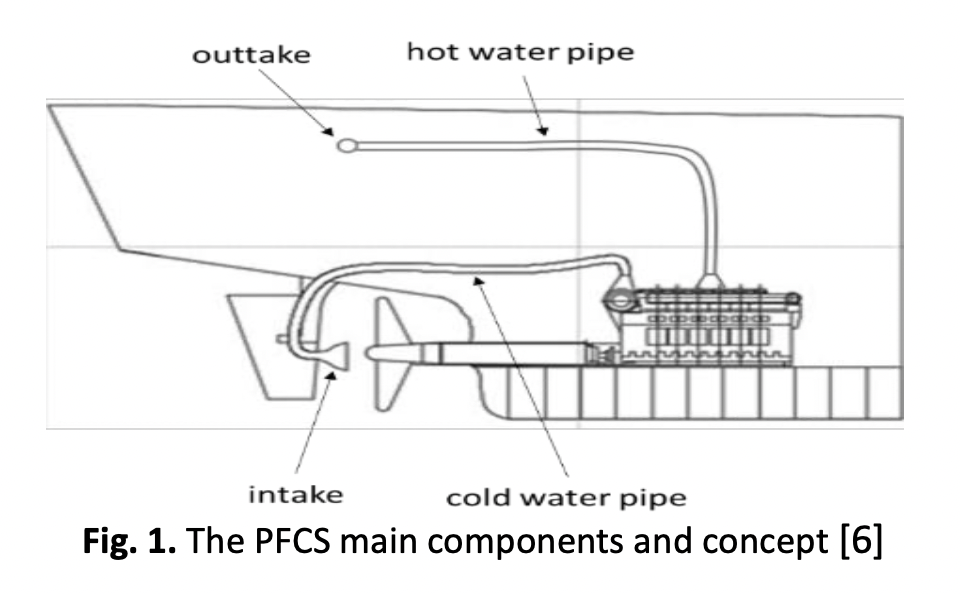Application of CFD Simulation to Determine the Optimal Horizontal Position of the Nozzle Inlet of a Propeller Flow Cooling System (PFCS)
DOI:
https://doi.org/10.37934/cfdl.16.2.5566Keywords:
Inlet Horizontal Distance, Computational Fluid Dynamic, Engine Cooling System, Propeller Flow Cooling System, Experiment ValidationAbstract
Research on the use of fluid flow caused by the propeller to be used for engine cooling is an interesting research topic. The system is known as the Propeller Flow Cooling System (PFCS). It is necessary to develop the most optimal position to produce maximum water discharge in this system. This research carried out simulation and analysis with an elliptical inlet nozzle as the utilization of the stern flow of the ship. This study aims to determine the difference in the volume of water generated from several horizontal positions of the nozzle inlet. In this study, the simulated horizontal distance of the inlet nozzle to the propeller at 0.7R propeller blade that is, 5 cm, 7.5 cm, 10 cm, 12.5 cm, 15 cm and using the computational dynamic fluid (CFD) method to analyze the optimal horizontal distance of the inlet nozzle which produces the highest water flow rate. Based on the research result, it was shown that the optimal horizontal distance of the inlet nozzle to the propeller is a distance of 7.5 cm. The water flow generated in the computational simulation in this case was 14.24 liters/minute. In that case, it can be concluded that the effect of the horizontal distance of the inlet nozzle on the propeller greatly affects the flow of water produced.Downloads
References
Ariafar, Kavous, David Buttsworth, Navid Sharifi, and Ray Malpress. "Ejector primary nozzle steam condensation: Area ratio effects and mixing layer development." Applied thermal engineering 71, no. 1 (2014): 519-527. https://doi.org/10.1016/j.applthermaleng.2014.06.038
I. Triyanti, “Analysis of the Effect of Foil Section Nozzle Shape on Ship Propulsion Efficiency on Tugboats,” Ten November Institute of Technology, 2015.
D. Hafiz, “Analysis of the Effect of Fluid Flow Caused by Propeller Rotational Movements on Fishing Vessels on Propeller Pressure With Approach,” Diponegoro University, 2011.
F. M. White, Fluid Mechanics, 2nd ed. New York, 1991.
Khan, Umair, William Pao, Nabihah Sallih, and Farruk Hassan. "Flow Regime Identification in Gas-Liquid Two-Phase Flow in Horizontal Pipe by Deep Learning." Journal of Advanced Research in Applied Sciences and Engineering Technology 27, no. 1 (2022): 86-91. https://doi.org/10.37934/araset.27.1.8691
Mahmuddin, F., S. Ramadhan, A. Fitriadhy, and S. Klara. "Performance Comparison Between Ellipse and Circular Intake Shapes of Propeller Flow Cooling System (PFCS) with Numerical and Experimental Methods." In IOP Conference Series: Materials Science and Engineering, vol. 676, no. 1, p. 012020. IOP Publishing, 2019. https://doi.org/10.1088/1757-899X/676/1/012020
Legiman and F. Sulaiman, “Maintenance And Repair Of The Mitsubishi Galant Engine Cooling System 2500 Cc,” Technovation J., vol. 1, no. 1, pp. 26–34, 2014.
Astriawati, N. I. N. G. R. U. M., and W. A. R. I. S. Wibowo. "Perawatan sistem pendingin mesin diesel pada whell loader komatsu wa120-3cs." Jurnal Teknovasi: Jurnal Teknik Dan Inovasi 7, no. 2 (2020): 76-85.
Anuar, Norsyazliana Syamira Saiful, Siti Hidayah Abu Talib, Nur Fatin Izureen Radzaly, Syarifah Intan Najla Syed Hashim, and Muhammad Salleh Abustan. "The effect of sedimentation to the pump sump system by using computational fluid dynamics (CFD) model." Journal of Advanced Research in Fluid Mechanics and Thermal Sciences 68, no. 1 (2020): 86-97. https://doi.org/10.37934/arfmts.68.1.8697
B. Harinaldi, Fluid Systems. Jakarta: Erlangga Publisher, 2015.
G. Mustafa, “CFD Analysis of Nozzle Effect on Jet Formation,” Sweden, 2015.
Li, Ben Q. Discontinuous finite elements in fluid dynamics and heat transfer. Springer Science & Business Media, 2006. https://doi.org/10.1007/1-84628-205-5
Vahaji, Sara, Aliakbar Akbarzadeh, Abhijit Shridhar Date, Chi Pok Cheung, and Jiyuan Tu. "Study on the efficiency of a convergent-divergent two-phase nozzle as a motive force for power generation from low temperature geothermal resources." In Proceedings of the World Geothermal Congress 2015 Australia-New Zealand (WGC 2015), pp. 1-14. Arinex Pty Ltd, 2015.
Safiu, Mahmudin. "Pengaruh Jarak Horizontal Nosel Inlet Terhadap Performa Sistem Pendingin Mesin Berbasis Daya Dorong Propeller= Effect Horizontal Distance Of Intake Shape To Performance Propeller Flow Cooling System (Pfcs)." PhD diss., Universitas Hasanuddin, 2021..
Bhutta, Muhammad Mahmood Aslam, Nasir Hayat, Muhammad Hassan Bashir, Ahmer Rais Khan, Kanwar Naveed Ahmad, and Sarfaraz Khan. "CFD applications in various heat exchangers design: A review." Applied Thermal Engineering 32 (2012): 1-12. https://doi.org/10.1016/j.applthermaleng.2011.09.001
Andersson, Bengt, Ronnie Andersson, Love Håkansson, Mikael Mortensen, Rahman Sudiyo, and Berend Van Wachem. Computational fluid dynamics for engineers. Cambridge university press, 2011. https://doi.org/10.1017/CBO9781139093590
Cifuentes, Oscar Darío Monsalve, Jonathan Graciano Uribe, and Diego Andrés Hincapié Zuluaga. "Numerical Simulation of a Propeller-Type Turbine for In-Pipe Installation." Journal of Advanced Research in Fluid Mechanics and Thermal Sciences 83, no. 1 (2021): 1-16. https://doi.org/10.37934/arfmts.83.1.116
Alfarawi, Suliman SS, Azeldin El-sawi, and Hossin Omar. "Exploring discontinuous meshing for cfd modelling of counter flow heat exchanger." Journal of Advanced Research in Numerical Heat Transfer 5, no. 1 (2021): 26-34.
T. Bikmukhametov, “CFD Simulations of multiphase flows with particles,” NTNU, 2016.
K. Yan, “Analisis Investigasi Pada Industri Pengecoran Propeller Kapal,” Politeknik Negeri Ujung Pandang, 2012.
Nursalim and A. Winarno, “Style Analysis Push the DPS IX Tug Because It Is Addition of Free Rotating Propeller With Using the Computed Fluid Method Dynamics (CFD),” Hang Tuah University, 2018.
A. Munawir, “Study Propeller Shaft Against Marine Propulsion,” V-Mac J., vol. 2, no. 1, pp. 18–24, 2017.




























